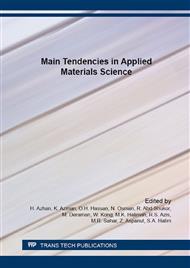[1]
Y. -H. Liang, C. -C. Wang, and C. -Y. Chen, The conductivity and characterization of the plasticized polymer electrolyte based on the P(AN-co-GMA-IDA) copolymer with chelating group, Journal of Power Sources, 148 (2005) 55–65.
DOI: 10.1016/j.jpowsour.2005.04.034
Google Scholar
[2]
G. Kalaignan, M. Kang, and Y. Kang, Effects of compositions on properties of PEO–KI–I2 salts polymer electrolytes for DSSC, Solid State Ionics, 177 (2006) 1091–1097.
DOI: 10.1016/j.ssi.2006.03.013
Google Scholar
[3]
T. Winie and a K. Arof, FT-IR studies on interactions among components in hexanoyl chitosan-based polymer electrolytes, Spectrochimica acta. Part A, Molecular and biomolecular spectroscopy, 63 (2006) 677–84.
DOI: 10.1016/j.saa.2005.06.018
Google Scholar
[4]
Y. Huang, X. Ma, X. Wang, and X. Liang, Determination of the interaction using FTIR within the composite gel polymer electrolyte, Journal of Molecular Structure, 1031 (2013) 30–37.
DOI: 10.1016/j.molstruc.2011.02.031
Google Scholar
[5]
Z. S. Mahmud, N. I. Adam, N. H. M. Zaki, A. M. M. Ali, and M. Z. A. Yahya, Conductivity and optical studies of plasticized polymer electrolytes based on 49% PMMA-grafted natural rubber, 2012 IEEE Symposium on Business, Engineering and Industrial Applications, (2012).
DOI: 10.1109/isbeia.2012.6422936
Google Scholar
[6]
R. Md Ali, N. I. Harun, A. M. Marwan Ali, and M. Z. A. Yahya, Effect of Temperature on Conductivity Studies of Cellulose Acetate Based Polymer Electrolytes, Advanced Materials Research, 667 (2013) 240–245.
DOI: 10.4028/www.scientific.net/amr.667.240
Google Scholar
[7]
K. Ragavendran, P. Kalyani, a Veluchamy, S. Banumathi, R. Thirunakaran, and T. J. Benedict, Characterization of Plasticized PEO Based Solid Polymer Electrolyte by XRD and AC Impedance Methods, Portugaliae Electrochimica Acta, 22 (2004) 149–159.
DOI: 10.4152/pea.200402149
Google Scholar
[8]
K. Kumutha and Y. Alias, FTIR spectra of plasticized grafted natural rubber-LiCF3SO3 electrolytes, Spectrochimica acta. Part A, Molecular and biomolecular spectroscopy, 64 (2006) 442–447.
DOI: 10.1016/j.saa.2005.07.044
Google Scholar
[9]
M. S. Su'ait, a. Ahmad, H. Hamzah, and M. Y. a. Rahman, Effect of lithium salt concentrations on blended 49% poly(methyl methacrylate) grafted natural rubber and poly(methyl methacrylate) based solid polymer electrolyte, Electrochimica Acta, 57 (2011).
DOI: 10.1016/j.electacta.2011.06.015
Google Scholar
[10]
A. A. Mohamad and A. K. Arof, Plasticized alkaline solid polymer electrolyte system, Materials Letters, 61 (2007) 3096–3099.
DOI: 10.1016/j.matlet.2006.11.030
Google Scholar
[11]
S. Ibrahim, R. Ahmad, and M. R. Johan, Conductivity and optical studies of plasticized solid polymer electrolytes doped with carbon nanotube, Journal of Luminescence, 132 (2012) 147–152.
DOI: 10.1016/j.jlumin.2011.08.004
Google Scholar


